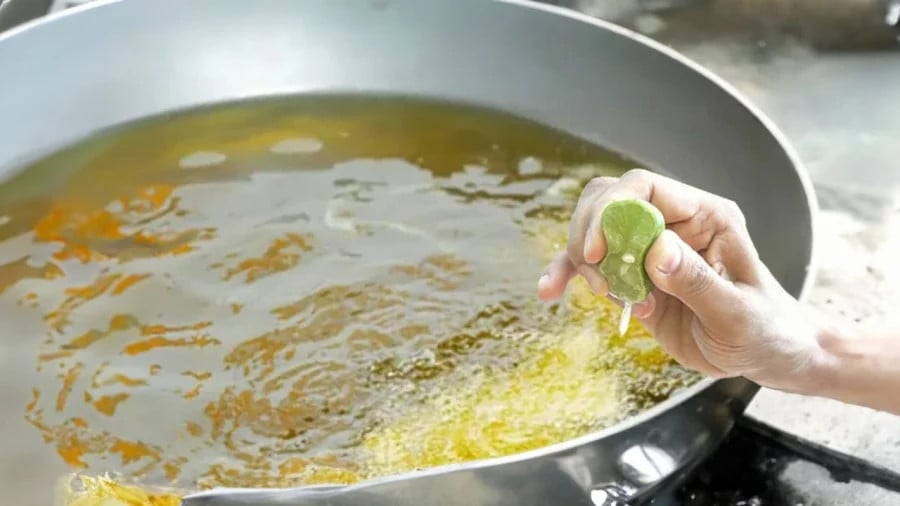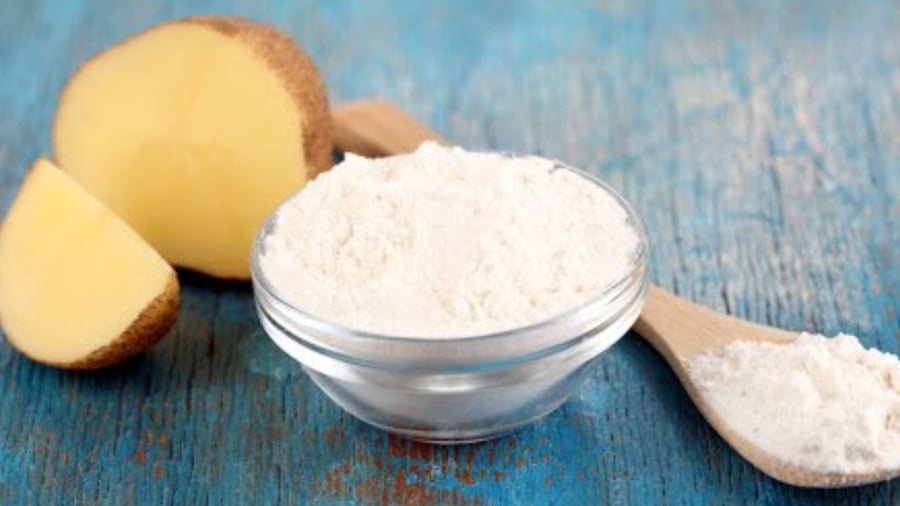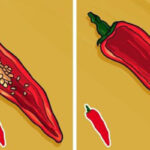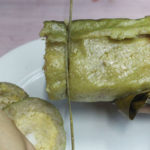Fried foods are beloved for their delicious flavor, crispy exterior, and soft interior. However, preparing these dishes is no easy feat. Many struggle with oil splatter, soggy or burnt food, and even burns if they’re not careful. So, how can you achieve that perfect crispiness without the mess? The following article will reveal some simple yet highly effective tips to boost your confidence in the kitchen.
1. The Secret Weapon of Lemon: For Longer-Lasting Crispiness and No Burning
One of the lesser-known secrets that experienced chefs and home cooks use is fresh lemon during frying. This technique not only prolongs the crispiness of the food but also reduces oil splatter and imparts a natural aroma.
How to use lemon when frying: Drop a slice of lemon into the hot oil and gently rub the bottom of the pan with chopsticks. The citric acid in the lemon neutralizes some of the oil and creates a protective layer that prevents splattering.

Squeeze a few drops of lemon juice into the oil before adding your food. This is especially effective when frying starchy foods like doughnuts, spring rolls, or fried noodles. Lemon helps the starch expand evenly, creating a beautiful puffed-up effect, while also making the food crispier and less soggy when cooled.
Additionally, lemon reduces the greasy smell, leaving a pleasant fragrance that’s ideal for those sensitive to frying odors.
2. A Pinch of Starch: The Trick to Reducing Splatter and Enhancing Crispness
Another way to minimize oil splatter and increase crispness is to use a small amount of starch (tapioca starch, cornstarch, flour, or special frying powder) before adding your food to the hot oil.
Method: Just before putting in your food, sprinkle about a teaspoon of starch into the hot oil.
The starch will absorb excess moisture from the food, reducing splatter and resulting in a crispier exterior.
Note: Avoid using too much starch, as it can burn and create an unpleasant burnt smell. The goal is to make the oil slightly “drier,” not to coat the food with a layer of starch.

3. A Few Grains of Salt: Simple Yet Effective
If you’re frying savory dishes, try adding a few grains of salt to the hot oil. Salt helps reduce splatter when it comes into contact with moist foods and also contributes to a slightly crispier texture.
4. Important Tips for Crispiness and Oil Control
In addition to the above tricks, some basic techniques during the frying process are crucial for achieving tasty and safe results:
– Ensure your pan is dry before adding oil: A pan with water residue is the main cause of oil splatter. Make sure your pan is completely dry and slightly warm before pouring in the oil.
– Get the oil temperature just right: If the oil isn’t hot enough, your food will absorb too much of it, resulting in a soggy texture. On the other hand, if the oil is too hot, it can burn the exterior. Test the oil by dipping chopsticks into it; when you see tiny bubbles forming around the chopsticks, the oil is ready.
– Defrost and pat dry your food: Cold or moist food will cause intense oil splatter. Ensure your food is completely defrosted and patted dry with paper towels before frying.
– Turn up the heat before removing the food: Just before taking out your fried food, increase the heat for a few seconds. This helps the food release excess oil, preventing greasiness and maintaining crispiness for longer.
Frying is an art, and home cooks are the artists in their kitchens. By employing simple tricks like using lemon, starch, and salt, and mastering the frying process, you can not only enhance the quality of your dishes but also protect yourself from oil burns. With these secrets, you’ll no longer fear oil splatter or soggy food.
Be sure to save these tips and share them with your loved ones so that everyone can enjoy easier and tastier cooking every day!
A Tasty Surprise: The Secret Ingredients to Take Your Dish to the Next Level
If you want to enhance the flavors of your favorite dishes, such as cakes, breads, fried eggs, stews, and stir-fries, there’s a simple solution. By incorporating a few secret ingredients into your recipes, you can take your taste buds on an exciting journey and elevate your dining experience to new heights. These ingredients will add a burst of flavor and a delightful twist to your meals, leaving you and your guests wanting more.
The Ultimate Guide to Crispy Fried Banh Tet: A Tasty Treat Without the Grease
“Banh tet is a beloved traditional delicacy, especially during Lunar New Year celebrations. However, this fried treat can be greasy and heavy, leading to an unpleasant, oily mouthfeel and potential weight gain. Today, we reveal the secret to achieving a crispy, delicious Banh tet without the oily aftermath. Prepare to impress your taste buds and keep your waistline happy too!”






































